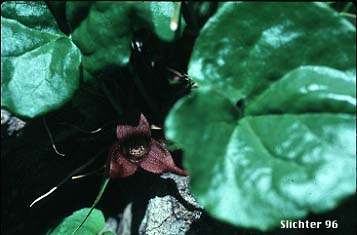

 Characteristics:
Characteristics:
Wild ginger is an attractive perennial with spreading, prostrate stems which help the species form extensive mats. The attractive heart-shaped leaves are opposite on the stems and are thick and leathery. The leaves are long petiolate, the smooth to hairy petioles measuring from 5-20 cm long. The blades are 4-10 cm long and up to 15 cm wide with obtuse to acute tips.
The flowers are usually found below the leaves. The peduncles range from 1-3 cm long while the brownish-purple to yellowish or greenish-yellow calyx is bulbous in shape and about 2-3 cm long. The calyx lobes are ovate and up to 2 cm long with a long narrow tip measuring 3-8 cm long and tapering gradually to the tip. Petals are absent. Due to their location next to the ground, the flowers are probably pollinated by crawling insects.
1. Roots eaten fresh or dried as a ginger subsitiute.
2. Tea from foots rids one of stomach pains.
3. Eating leaves makes one hungry and they may be used as a tuberculosis cure.
4. Wild ginger makes an attractive mat-forming wildflower for the shady garden. Young plants may be eaten by slugs, but older plants seem to be resistant to them.
Wild ginger is typically found in thick, rich soil of moist, shady woods. It is most common below 4000'. Some individuals may be found in open talus slopes at timberline. These seem to be more tolerant of sunshine.
Wild ginger is found from British Columbia south to Oregon and east to northern Montana and western Montana.
In the Columbia River Gorge, it may be found from 100'-3600' from the western approaches to the gorge to as far east as the vicinity of Hood River, OR and Bingen, WA.